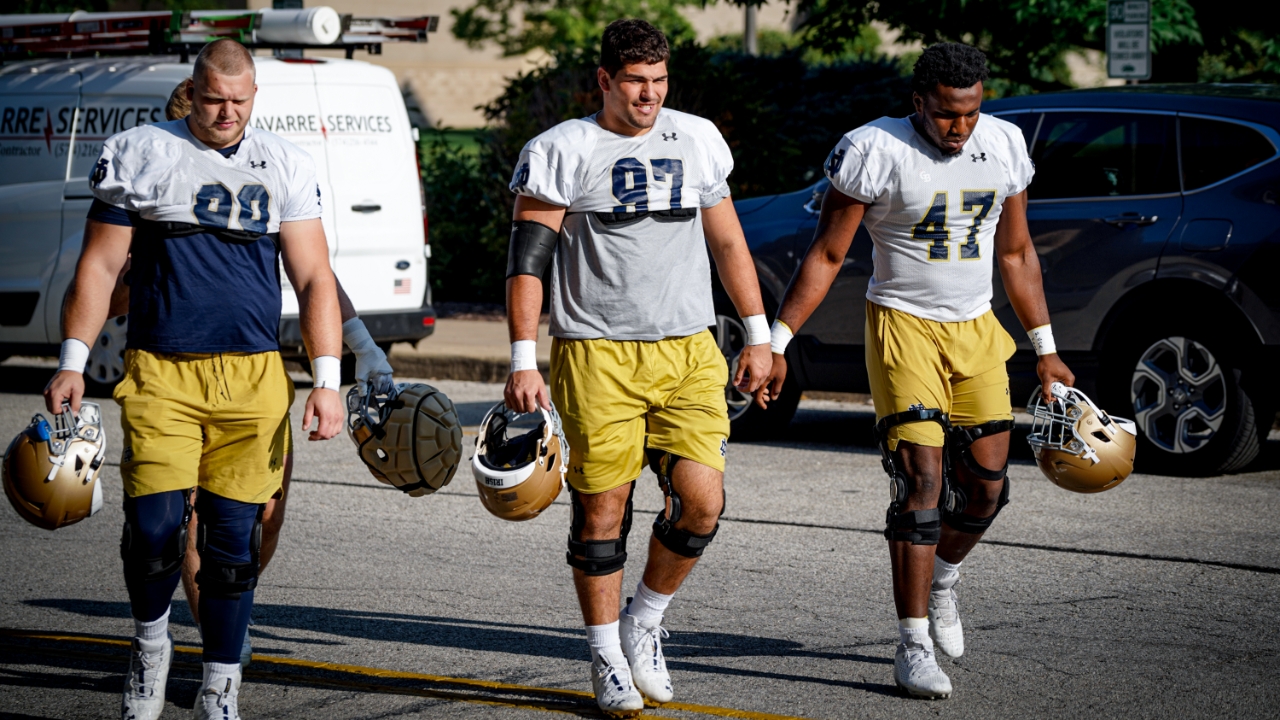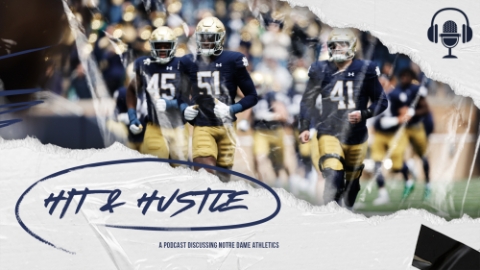
Just using typical counting stats, Notre Dame’s run defense was slightly above average last season.
They gave up 3.92 yards per carry (52nd) and only 131.3 yards per game (37th). That’s not dominant by any means, but also not horrible.
Not many layers have to be peeled back to reveal that those numbers don’t give an accurate reflection of their run defense. They were 103rd in EPA (expected points added) per rush. That means that when digging into how they performed situationally, they weren’t very good.
They also were 91st in opportunity rate, which is the percentage of carries (when four yards are available) that gain at least four yards. That’s not ideal.
The defense struggled the most to stopping the run against teams who posed the biggest threats to them in the passing game. Against CJ Stroud and those great receivers for Ohio State, they couldn’t afford to load the box and win with numbers to stop the run. The Buckeyes averaged 4.9 yards per carry, their EPA on rush attempts was in the 94th percentile, and they had a 59% success rate on rushing attempts.
It was the same against Caleb Williams and USC. Notre Dame had to try to stop the run with even numbers and failed. They gave up 6.0 yards per rush, USC’s EPA on rush attempts was in the 90th percentile, and they had 62% success rate on rushing attempts.
USC and Ohio State (1st and 7th in EPA per rush) did this to just about everyone, but that’s not really the point. The point is that Notre Dame has these two on the schedule again this fall and if they’re going to win those games, they have to be improved at stopping the run.
The good news is that the Irish are better equipped to do so this fall. Some of it is that everyone is playing faster and looking more comfortable in Al Golden’s defense compared to how they were last year. The bigger part of it is personnel.
The Irish look much stronger up the middle than they were in 2022. It all starts up front at defensive tackle where they are not only more disruptive, but they are significantly bigger. The top-five defensive tackles last year (Howard Cross, Jayson Ademilola, Gabriel Rubio, Chris Smith, and Jacob Lacey) averaged 6-2 ⅛ 289 across the board. This season’s top-four (Cross, Rubio, Rylie Mills, and Jason Onye) averaged 6-4 298.
They are better suited to win at the point of attack and moving Mills back inside and the emergence of Onye has also upgraded the athleticism. Cross is 12 pounds heavier than he was in 2022 and has not slowed down one bit. Mills, 10th on Bruce Feldman’s Freaks List, looks better than he has at any point during his career at Notre Dame and has been more violent at the point of attack, but it’s Rubio and Onye that really take this group to a different level than they one we saw last season.
Earlier in camp, defensive line coach Al Washington praised how much both have progressed on the field.
“You guys (the media) have to come up with a nickname for those guys,” Washington said. “Those are two 300-pound bash brothers and they are dependable, willing. They’re physical, fundamentally sound. Powerful. The same thing you like about big athletic guys that are disruptive.”
(For more on the ascension of Onye and Rubio, check out Andrew Mentock’s piece)
Behind them the Irish return JD Bertrand, Marist Liufau, and Jack Kiser at linebacker, but there were questions about that group after last season. There are less questions about that group now with Bertrand continuing to look like he has improved from the player he was last fall and Kiser settled in playing his second year as an inside linebacker.
The biggest boost could come from Liufau. Banged up last August after being out for the 2021 season, he’s had a great camp with flashes as an edge rusher in sub-packages and looking more like the playmaker he was supposed to be prior to his injury when playing the inside run as the Will.
Add in young linebackers like Jaylen Sneed, Drayk Bowen, and Jaiden Ausberry and the Irish are deeper and more athletic at the position in 2023.
One of the more underrated personnel upgrades this season that could have a significant impact with the run defense for the Irish is at safety, where Xavier Watts is going to have a bigger role. He finished 9th in PFF’s run defense grade out of Power 5 safeties in 2022 and 5th in “stop percentage”, which is the percentage of tackles that constitute a failure for the offense.
He’s a much better run defender than Brandon Joseph, who led Notre Dame’s safeties in snaps per game last season.
Three of the four College Football Playoff teams in 2022 (Georgia, Michigan, and Ohio State) had defenses that finished in the top-11 in EPA per rush. It might be a lot to ask for Notre Dame to get to that level against the run this fall.
They will be a lot better, though, because the middle of their defense is going to be a lot better than it was last season. And with the talent they have at corner and options they have to rush the passer, the ceiling of the defense is a much higher than it was in 2022.
Men's Under Armour Navy Notre Dame Fighting Irish 2023 Aer Lingus College Football Classic Replica Jersey



